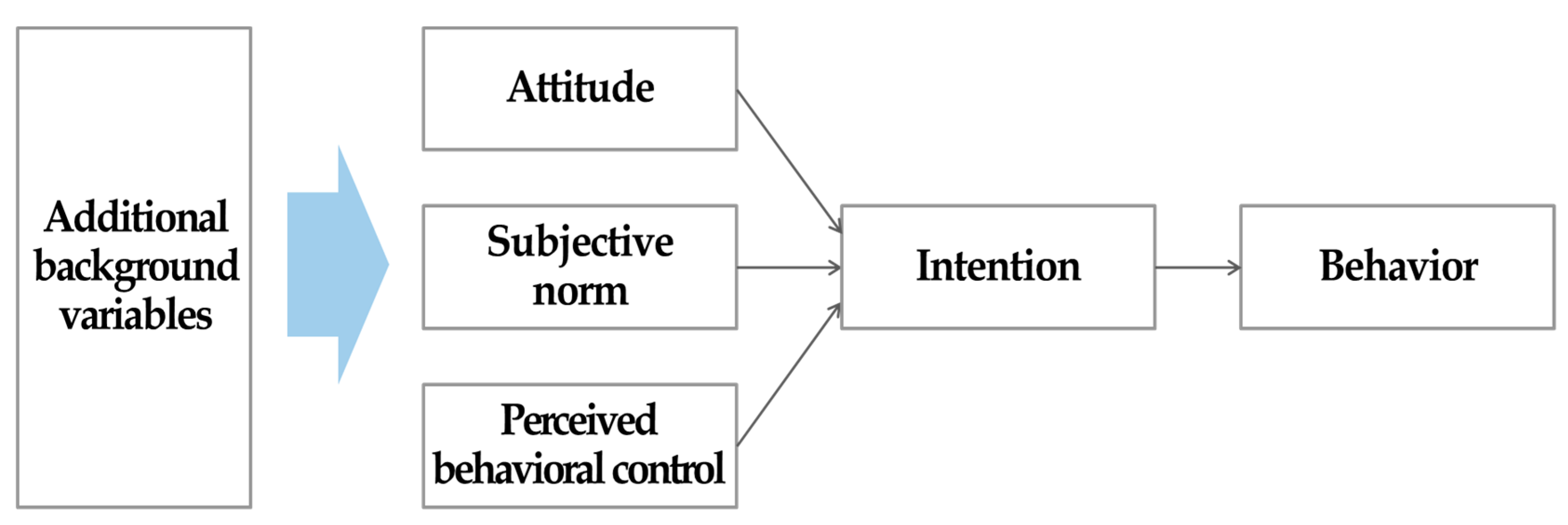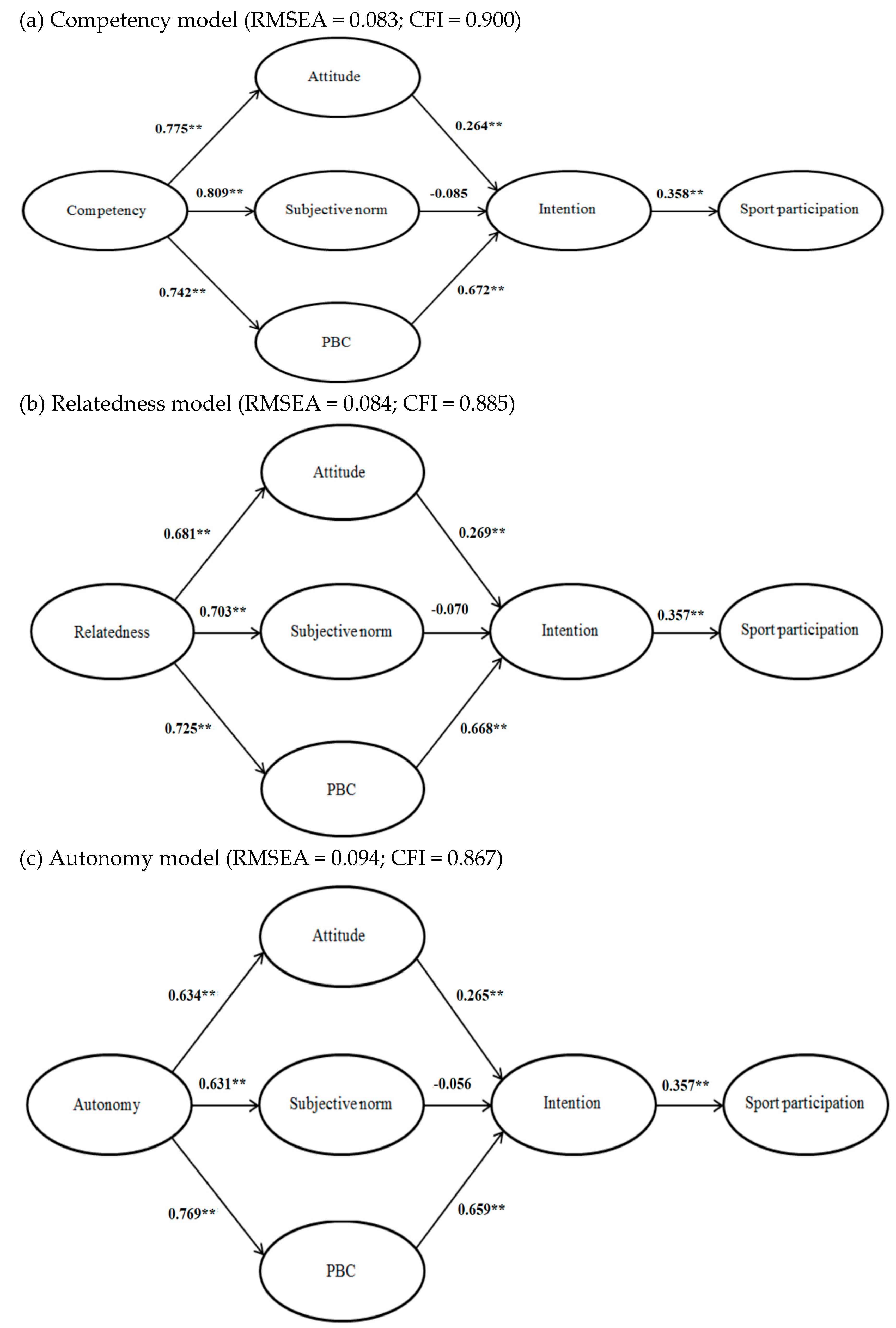A Developmental Model for Predicting Sport Participation among Female Korean College Students
Abstract
1. Introduction
2. Methodology
2.1. Data
2.2. Measures
2.3. Statistical Analysis
3. Results
4. Discussion
5. Conclusions
Author Contributions
Funding
Conflicts of Interest
References
- Kohrt, W.M.; Bloomfield, S.A.; Little, K.D.; Nelson, M.E.; Yingling, V.R. American College of Sports Medicine position stand: Physical activity and bone health. Med. Sci. Sports Exerc. 2004, 36, 1985–1996. [Google Scholar] [CrossRef] [PubMed]
- Bassuk, S.S.; Manson, J.E. Epidemiological evidence for the role of physical activity in reducing risk of type 2 diabetes and cardiovascular disease. J. Appl. Physiol. 2005, 99, 1193–1204. [Google Scholar] [CrossRef] [PubMed]
- Sigal, R.J.; Kenny, G.P.; Wasserman, D.H.; Castaneda-Sceppa, C.; White, R.D. Physical activity/exercise and type 2 diabetes. Diabetes Care 2006, 29, 1433–1438. [Google Scholar] [CrossRef]
- Leith, L.M. Foundations of Exercise and Mental Health; Fitness Information Technology: Morgantown, WV, USA, 2010. [Google Scholar]
- American College Health Association. American College Health Association—National College Health Assessment II: Reference Group Data Report Spring 2010; American College Health Association: Linthicum, MD, USA, 2010. [Google Scholar]
- Kim, Y.B.; Park, C.M.; Kim, H.H.; Han, C.H. Health behavior and utilization of university health clinics. J. Korean Soc. School Commun. Health Educ. 2010, 11, 79–91. [Google Scholar]
- Allan, J.D. Identification of health risks in a young adult population. J. Commun. Health Nurs. 1987, 4, 223–233. [Google Scholar] [CrossRef]
- Pepe, M.V.; Gandee, R.F. Ohio Senior Olympics: Creating the new adult image. In Physical Activity, Aging and Sports: Practice, Program and Policy; Harris, W., Harris, R., Harris, W., Eds.; The Center for the Study of Aging: New York, NY, USA, 1992; pp. 75–82. [Google Scholar]
- Stevenson, C.L. Seeking identities: Towards an understanding of the athletic careers of masters swimmers. Int. Rev. Sociol. Sport 2002, 37, 131–146. [Google Scholar] [CrossRef]
- Grol, R.P.; Bosch, M.C.; Hulscher, M.E.; Eccles, M.P.; Wensing, M. Planning and studying improvement in patient care: The use of theoretical perspectives. Milbank Q. 2007, 85, 93–138. [Google Scholar] [CrossRef] [PubMed]
- Glanz, K.; Rimer, B.K.; Viswanath, K. Health Behavior and Health Education: Theory, Research, and Practice, 3rd ed.; Jossey-Bass: San Francisco, CA, USA, 2008. [Google Scholar]
- Conner, M.; Sparks, P. Theory of planned behaviour and health behaviour. Predict. Health Behav. 2005, 2, 121–162. [Google Scholar]
- Ajzen, I. The theory of planned behavior. Organ. Behav. Hum. Decis. Process. 1991, 50, 179–211. [Google Scholar] [CrossRef]
- Ajzen, I.; Albarracin, D. Predicting and changing behavior: A reasoned action approach. In Prediction and Change of Health Behavior: Applying the Reasoned Action Approach; Ajzen, I., Albarracin, D., Hornik, R., Eds.; Lawrence Erlbaum: Mahwah, NJ, USA, 2007. [Google Scholar]
- Bozinelos, G.; Bennett, P. The theory of planned behavior as predictor of exercise: The moderating influence of beliefs and personality variables. J. Health Psychol. 1999, 4, 517–529. [Google Scholar] [CrossRef]
- Rhodes, R.E.; Courneya, K.S.; Jone, L.W. Personality and social cognitive influences on exercise behavior: Adding the activity trait to the theory of planned behavior. Psychol. Sport Exerc. 2004, 5, 243–254. [Google Scholar] [CrossRef]
- Hamilton, K.; White, K.M. Extending the theory of planned behavior: The role of self and social influences in predicting adolescent regular moderate-to-vigorous physical activity. J. Sport Exerc. Psychol. 2008, 30, 56–74. [Google Scholar] [CrossRef] [PubMed]
- Hennessy, M.; Bleakley, A.; Fishbein, M.; Brown, L.; Diclemente, R.; Romer, D.; Valois, R.; Vanable, P.A.; Carey, M.P.; Salazar, L. Differentiating between precursor and control variables when analyzing reasoned action theories. AIDS Behav. 2010, 14, 225–236. [Google Scholar] [CrossRef] [PubMed]
- Deci, E.L.; Ryan, R.M. The “what” and “why” of goal pursuits: Human needs and the self-determination of behavior. Psychol. Inq. 2000, 11, 227–268. [Google Scholar] [CrossRef]
- Sheldon, K.M.; Elliot, A.J.; Kim, Y.; Kasser, T. What is satisfying about satisfying events? Testing 10 candidate psychological needs. J. Pers. Soc. Psychol. 2001, 80, 325–339. [Google Scholar] [CrossRef] [PubMed]
- Hagger, M.S.; Chatzisarantis, N.L.; Harris, J. From psychological need satisfaction to intentional behavior: Testing a motivational sequence in two behavioral contexts. Pers. Soc. Psychol. Bull. 2006, 32, 131–148. [Google Scholar] [CrossRef]
- Stevens, J. Applied Multivariate Statistics for the Social Sciences; Lawrence Erlbaum Associates: Mahwah, NJ, USA, 1996. [Google Scholar]
- Muthén, L.K.; Muthén, B.O. Mplus User’s Guide; Muthén & Muthén: Los Angeles, CA, USA, 2006. [Google Scholar]
- Sobel, M.E. Asymptotic confidence intervals for indirect effects in structural equation models. Sociol. Methodol. 1982, 13, 290–312. [Google Scholar] [CrossRef]
- Lockwood, C.M.; MacKinnon, D.P. Bootstrapping the standard error of the mediated effect. In Proceedings of the 23rd Annual Meeting of SAS Users Group International; Lockwood, C.M., MacKinnon, D.P., Eds.; SAS Institute, Inc.: Cary, NC, USA, 1998; pp. 997–1002. [Google Scholar]
- Hu, L.T.; Bentler, P.M. Cutoff criteria for fit indexes in covariance structure analysis: Conventional criteria versus new alternatives. Struct. Equ. Model. 1999, 6, 1–55. [Google Scholar] [CrossRef]
- Steiger, J.H. Understanding the limitations of global fit assessment in structural equation modeling. Pers. Individ. Differ. 2007, 42, 893–898. [Google Scholar] [CrossRef]
- Iacobucci, D. Structural equations modeling: Fit indices, sample size, and advanced topics. Sample Size, and Advanced Topics. J. Consum. Psychol. 2010, 20, 90–98. [Google Scholar] [CrossRef]
- Noar, S.M.; Zimmerman, R.S. Health Behavior Theory and cumulative knowledge regarding health behaviors: Are we moving in the right direction? Health Educ. Res. 2005, 20, 275–290. [Google Scholar] [CrossRef]
- McEachen, R.R.C.; Conner, M.; Taylor, N.J.; Lawton, R.J. Prospective prediction of health-related behaviors with the theory of planned behavior: A meta-analysis. Health Psychol. Rev. 2011, 5, 97–144. [Google Scholar] [CrossRef]
- Hall, M.A. Feminism and Sporting Bodies: Essays on Theory and Practice; Human Kinetics Publishers: Windsor, ON, USA, 1996. [Google Scholar]
- Cockburn, C.; Clarke, G. “Everybody’s looking at you!”: Girls negotiating the “femininity deficit” they incur in physical education. Womens Stud. Int. Forum 2002, 25, 651–665. [Google Scholar] [CrossRef]
- Chung, Y.N. Women’s constraints to participation in leisure sports. Korea J. Sports Sci. 2008, 17, 295–307. [Google Scholar]
- Vallerand, R.J. Toward a hierarchical model of intrinsic and extrinsic motivation. Adv. Exp. Soc. Psychol. 1997, 29, 271–360. [Google Scholar]
- Guay, F.; Mageau, G.A.; Vallerand, R.J. On the hierarchical structure of self-determined motivation: A test of top-down, bottom-up, reciprocal, and horizontal effects. Pers. Soc. Psychol. Bull. 2003, 29, 992–1004. [Google Scholar] [CrossRef]
- Hagger, M.S.; Chatzisarantis, N.L.; Culverhouse, T.; Biddle, S.J. The processes by which perceived autonomy support in physical education promotes leisure-time physical activity intentions and behavior: A trans-contextual model. J. Educ. Psychol. 2003, 95, 784–795. [Google Scholar] [CrossRef]
- Keating, X.D.; Guan, J.; Piñero, J.C.; Bridges, D.M. A meta-analysis of college students’ physical activity behaviors. J. Am. College Health 2005, 54, 116–126. [Google Scholar] [CrossRef]
- Li, W.; Lee, A.; Solmon, M. The role of perceptions of task difficulty in relation to self-perceptions of ability, intrinsic value, attainment value, and performance. Eur. Phys. Educ. Rev. 2007, 13, 301–318. [Google Scholar] [CrossRef]


| Characteristics | Mean | SD |
|---|---|---|
| Sport participation (minute/week) | 64.18 | 122.94 |
| Age (years) | 20.36 | 1.83 |
| n | % | |
| 18 | 103 | 20.9 |
| 19 | 81 | 16.4 |
| 20 | 62 | 12.6 |
| 21 | 143 | 28.9 |
| 22 | 27 | 5.5 |
| 23 | 58 | 11.7 |
| 24 | 11 | 2.2 |
| 25 | 5 | 1.0 |
| 26 | 3 | 0.6 |
| 27 | 1 | 0.2 |
| College year | ||
| Freshman | 173 | 35.02 |
| Sophomore | 77 | 15.58 |
| Junior | 163 | 33 |
| Senior | 81 | 16.4 |
| Residence type | ||
| Living with parents | 351 | 71.05 |
| Living apart from parents (off-campus) | 83 | 16.81 |
| Living apart from parents (on-campus) | 51 | 10.32 |
| Others | 9 | 1.82 |
| Household income | ||
| Low | 166 | 33.61 |
| Middle | 243 | 49.19 |
| High | 85 | 17.2 |
| Indirect Effects | Coefficients | |||
|---|---|---|---|---|
| Competency | Attitude | Intention | Sport participation | 0.073 ** |
| Subjective norm | Intention | Sport participation | −0.025 | |
| Perceived behavioral control | Intention | Sport participation | 0.179 ** | |
| Relatedness | Attitude | Intention | Sport participation | 0.065 ** |
| Subjective norm | Intention | Sport participation | −0.017 | |
| Perceived behavioral control | Intention | Sport participation | 0.173 ** | |
| Autonomy | Attitude | Intention | Sport participation | 0.060 ** |
| Subjective norm | Intention | Sport participation | −0.013 | |
| Perceived behavioral control | Intention | Sport participation | 0.181 ** | |
© 2020 by the authors. Licensee MDPI, Basel, Switzerland. This article is an open access article distributed under the terms and conditions of the Creative Commons Attribution (CC BY) license (http://creativecommons.org/licenses/by/4.0/).
Share and Cite
Park, S.-U.; Lee, C.G.; Kim, D.-K.; Park, J.-H.; Jang, D.-J. A Developmental Model for Predicting Sport Participation among Female Korean College Students. Int. J. Environ. Res. Public Health 2020, 17, 5010. https://doi.org/10.3390/ijerph17145010
Park S-U, Lee CG, Kim D-K, Park J-H, Jang D-J. A Developmental Model for Predicting Sport Participation among Female Korean College Students. International Journal of Environmental Research and Public Health. 2020; 17(14):5010. https://doi.org/10.3390/ijerph17145010
Chicago/Turabian StylePark, Sung-Un, Chung Gun Lee, Dong-Kyu Kim, Jong-Hwa Park, and Deok-Jin Jang. 2020. "A Developmental Model for Predicting Sport Participation among Female Korean College Students" International Journal of Environmental Research and Public Health 17, no. 14: 5010. https://doi.org/10.3390/ijerph17145010
APA StylePark, S.-U., Lee, C. G., Kim, D.-K., Park, J.-H., & Jang, D.-J. (2020). A Developmental Model for Predicting Sport Participation among Female Korean College Students. International Journal of Environmental Research and Public Health, 17(14), 5010. https://doi.org/10.3390/ijerph17145010






